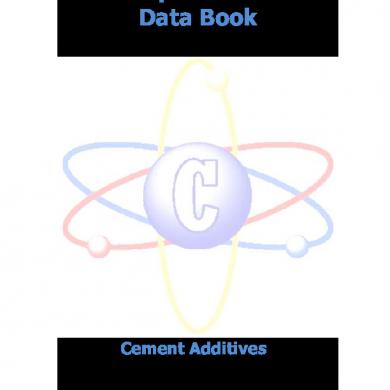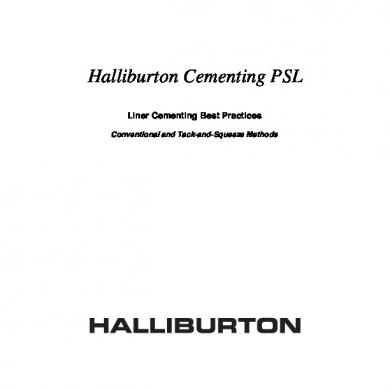Cementing
This document was uploaded by user and they confirmed that they have the permission to share it. If you are author or own the copyright of this book, please report to us by using this DMCA report form. Report DMCA
Overview
Download & View Cementing as PDF for free.
More details
- Words: 758
- Pages: 39
Loading documents preview...
Heavy Oil Cementing Jose David Vela Principal Technical Prof. Fluid Systems Quito, Ecuador
November 29, 2006
Good Cementing from first time Avoid annular communication trough well life & reduce expensive workovers
GOOD RESULTS
Cement Challenges on Thermal Recovery Projects
Cement Challenges on Thermal Recovery Projects
High Temperatures Preventing Strength Retrogression
First High Temperature Cements
Portland Cement > 230 F •Strength Retrogression •Increase in Permeability •Industry Adapted Portland Plus 35% to 40% Silica Flour
Properties are virtually retained
“G” + 35 % SSA-1
Reduced CS and increased porosity & permeability
Neat “G”
Effective Mud Displacement to Prevent Casing Buckling & Shearing
Casing Buckling & Shearing
Residual Mud Pockets can cause casing Buckling
How to Improve? • Best Cementing Practices • Reduce washouts
Casing Buckling & Shearing
Casing Caliper Buckling Measurements
Need good bond and flexible cement properties
Solution: Thermatek
Insulating the Wellbore
Insulating the Wellbore
Benefits
• • • • •
Lower the Steam to Oil Ratio Less Energy Used More Economic Production Marginal Fields now Economical More Environmentally Friendly
Conduction, Convection & Radiation HT
Insulating the Wellbore
Q
r1 r2
Heat Transfer Rate 2 Pi L kef (T1 – T2) Q= ln(r2 / r1)
Thermal Conductivity of Cements kef (W/mK)
Neat Cement
0.9
MicroSphere
0.5
ZoneSeal (Foam)
0.2
Q ≈ kef As
kef
Q
Cyclic Loading in the Wellbore
Well Events After Primary Cementing • Cement Hydration & hydration volume reduction
• Completions & pressure decrease inside the casing
• Pressure Testing & pressure increase inside the casing
• Hydraulic Fracturing & pressure increase
• Production & pressure/temperature increase inside tubulars
Modes of Cement Failure
De-bonding
@ rock-cement interface De-bonded
@ cement-casing interface
Rock Cement
Casing
Casing
Cement De-bonded De-bonded
Rock
Modes of Cement Failure
Deformation
Cracks Rock
Cement
Rock Cement
Casing
Casing
Design and Testing
Lab Test Damaged Cement Sheath
Resilient Sheath – No Damage
Lab Testing
Material Strength and Deformation
Stress
1
Brittle
2 Ductile
1
Strain
2
Typical Young’s Modulus Steel 3.0* 107 psi
Aluminum
“neat cement”
1.0* 107 psi
1.5*10 psi 6
“modified” cement 0.2*106 psi
Typical Young’s Modulus Nitrogen
Steel 3.0* 107 psi
Aluminum
“neat cement”
1.0* 107 psi
1.5*10 psi 6
“modified” cement 0.2*106 psi
Typical Young’s Modulus Nitrogen
Steel 3.0* 107 psi
Aluminum
“neat cement”
1.0* 107 psi
1.5*10 psi 6
“modified” cement 0.2*106 psi
Typical Young’s Modulus Nitrogen
Steel 3.0* 107 psi
Aluminum
“neat cement”
1.0* 107 psi
1.5*10 psi 6
“modified” cement 0.2*106 psi
Typical Young’s Modulus Nitrogen
Steel 3.0* 107 psi
Aluminum
“neat cement”
1.0* 107 psi
1.5*10 psi 6
“modified” cement 0.2*106 psi
Engineering Analysis
Analysis Damaged Cement Sheath
Resilient Sheath – No Damage
Lab Test
Analysis Cement
formation
casing
WellLife® Analysis
Data Needed for FEA Analysis Rock properties • Casing properties • Cement slurry and sheath properties •
• • • • •
Young’s Modulus Poisson Ratio Compressive Yield Parameters Tensile strength Effective volume change from cement hydration
• Operation details • Completion • Stimulation • Production
Rock Casing Cement
Cyclic Loading
Stress in the material should be below a certain value so that it can withstand a large number of cycles
Cyclic Loading Stress in the material should be below a certain value so that it can withstand a large number of cycles
Ultimate Strength (failed)
Stress
Number of Cycles
Cyclic Loading Stress in the material should be below a certain value so that it can withstand a large number of cycles
x
Ultimate Strength (failed)
Stress
Number of Cycles
Cyclic Loading Stress in the material should be below a certain value so that it can withstand a large number of cycles
x Stress
Ultimate Strength (failed)
x
Number of Cycles
Cyclic Loading Stress in the material should be below a certain value so that it can withstand a large number of cycles
x Stress
Ultimate Strength (failed)
x x
Number of Cycles
Cyclic Loading Stress in the material should be below a certain value so that it can withstand a large number of cycles
x Stress
Ultimate Strength (failed)
x x
Number of Cycles
x
Cyclic Loading Stress in the material should be below a certain value so that it can withstand a large number of cycles
x Stress
Ultimate Strength (failed)
x x
Number of Cycles
x
x
Cyclic Loading Stress in the material should be below a certain value so that it can withstand a large number of cycles
x Stress
Ultimate Strength (failed)
x x
Endurance Limit
Number of Cycles
x
x
November 29, 2006
Good Cementing from first time Avoid annular communication trough well life & reduce expensive workovers
GOOD RESULTS
Cement Challenges on Thermal Recovery Projects
Cement Challenges on Thermal Recovery Projects
High Temperatures Preventing Strength Retrogression
First High Temperature Cements
Portland Cement > 230 F •Strength Retrogression •Increase in Permeability •Industry Adapted Portland Plus 35% to 40% Silica Flour
Properties are virtually retained
“G” + 35 % SSA-1
Reduced CS and increased porosity & permeability
Neat “G”
Effective Mud Displacement to Prevent Casing Buckling & Shearing
Casing Buckling & Shearing
Residual Mud Pockets can cause casing Buckling
How to Improve? • Best Cementing Practices • Reduce washouts
Casing Buckling & Shearing
Casing Caliper Buckling Measurements
Need good bond and flexible cement properties
Solution: Thermatek
Insulating the Wellbore
Insulating the Wellbore
Benefits
• • • • •
Lower the Steam to Oil Ratio Less Energy Used More Economic Production Marginal Fields now Economical More Environmentally Friendly
Conduction, Convection & Radiation HT
Insulating the Wellbore
Q
r1 r2
Heat Transfer Rate 2 Pi L kef (T1 – T2) Q= ln(r2 / r1)
Thermal Conductivity of Cements kef (W/mK)
Neat Cement
0.9
MicroSphere
0.5
ZoneSeal (Foam)
0.2
Q ≈ kef As
kef
Q
Cyclic Loading in the Wellbore
Well Events After Primary Cementing • Cement Hydration & hydration volume reduction
• Completions & pressure decrease inside the casing
• Pressure Testing & pressure increase inside the casing
• Hydraulic Fracturing & pressure increase
• Production & pressure/temperature increase inside tubulars
Modes of Cement Failure
De-bonding
@ rock-cement interface De-bonded
@ cement-casing interface
Rock Cement
Casing
Casing
Cement De-bonded De-bonded
Rock
Modes of Cement Failure
Deformation
Cracks Rock
Cement
Rock Cement
Casing
Casing
Design and Testing
Lab Test Damaged Cement Sheath
Resilient Sheath – No Damage
Lab Testing
Material Strength and Deformation
Stress
1
Brittle
2 Ductile
1
Strain
2
Typical Young’s Modulus Steel 3.0* 107 psi
Aluminum
“neat cement”
1.0* 107 psi
1.5*10 psi 6
“modified” cement 0.2*106 psi
Typical Young’s Modulus Nitrogen
Steel 3.0* 107 psi
Aluminum
“neat cement”
1.0* 107 psi
1.5*10 psi 6
“modified” cement 0.2*106 psi
Typical Young’s Modulus Nitrogen
Steel 3.0* 107 psi
Aluminum
“neat cement”
1.0* 107 psi
1.5*10 psi 6
“modified” cement 0.2*106 psi
Typical Young’s Modulus Nitrogen
Steel 3.0* 107 psi
Aluminum
“neat cement”
1.0* 107 psi
1.5*10 psi 6
“modified” cement 0.2*106 psi
Typical Young’s Modulus Nitrogen
Steel 3.0* 107 psi
Aluminum
“neat cement”
1.0* 107 psi
1.5*10 psi 6
“modified” cement 0.2*106 psi
Engineering Analysis
Analysis Damaged Cement Sheath
Resilient Sheath – No Damage
Lab Test
Analysis Cement
formation
casing
WellLife® Analysis
Data Needed for FEA Analysis Rock properties • Casing properties • Cement slurry and sheath properties •
• • • • •
Young’s Modulus Poisson Ratio Compressive Yield Parameters Tensile strength Effective volume change from cement hydration
• Operation details • Completion • Stimulation • Production
Rock Casing Cement
Cyclic Loading
Stress in the material should be below a certain value so that it can withstand a large number of cycles
Cyclic Loading Stress in the material should be below a certain value so that it can withstand a large number of cycles
Ultimate Strength (failed)
Stress
Number of Cycles
Cyclic Loading Stress in the material should be below a certain value so that it can withstand a large number of cycles
x
Ultimate Strength (failed)
Stress
Number of Cycles
Cyclic Loading Stress in the material should be below a certain value so that it can withstand a large number of cycles
x Stress
Ultimate Strength (failed)
x
Number of Cycles
Cyclic Loading Stress in the material should be below a certain value so that it can withstand a large number of cycles
x Stress
Ultimate Strength (failed)
x x
Number of Cycles
Cyclic Loading Stress in the material should be below a certain value so that it can withstand a large number of cycles
x Stress
Ultimate Strength (failed)
x x
Number of Cycles
x
Cyclic Loading Stress in the material should be below a certain value so that it can withstand a large number of cycles
x Stress
Ultimate Strength (failed)
x x
Number of Cycles
x
x
Cyclic Loading Stress in the material should be below a certain value so that it can withstand a large number of cycles
x Stress
Ultimate Strength (failed)
x x
Endurance Limit
Number of Cycles
x
x
Related Documents

Cementing
January 2021 1
Cementing
January 2021 4
Cementing Additives
January 2021 1
Halliburton Cementing Psl: Liner Cementing Best Practices
January 2021 1
Deepwater Cementing
January 2021 3
Well Cementing
January 2021 1More Documents from "wasayraza"
